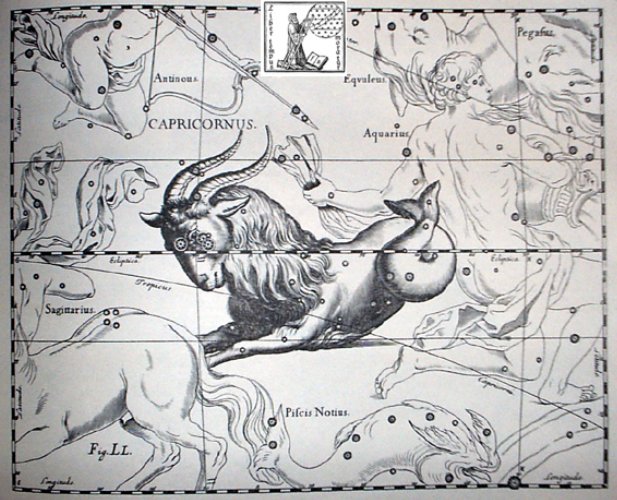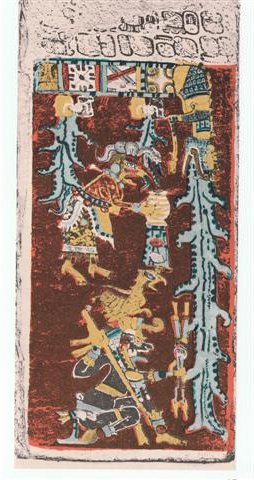The
star
at
manu
kake
(the
'climbing
bird')
in
Ga3-1
had once
upon
a
time
been
in
MAY
20,
i.e.
60
days
after
0h,
but
when
in
Roman
times
the
Sun
calendar
was
realigned
with
the
Moon
calendar
-
which
I
have
assumed
- the
day
number
had become
177
= 6
(Sun)
*
29½
(Moon)
=
360
-
183:
 |
 |
 |
 |
| Ga2-27 |
Ga2-28 |
Ga2-29 |
Ga3-1 (60) |
| MAY 17 (364 - 227 = 137) |
18 (228 - 90 = 138) |
19 |
20 (140) |
| 8h (121.7) |
ρ Puppis (122.0), Heap of Fuel (122.1), ζ Monocerotis (122.3), ψ Cancri (122.6), Regor (122.7) |
Tegmine (123.3) |
Al Tarf
(124.3)
Ras Algethi
|
| χ Gemini (121.0), Naos (121.3) |
| July 20 (201) |
21 (*122) |
7-22 |
23 |
| ºJuly 16 (181 + 16) |
17 (*118) |
18 |
19 (200) |
| 'June 23 |
ST JOHN'S EVE |
25 (*96) |
26 (177) |
| "June 9 (*80) |
10 |
11 |
12 (163) |
| NAKSHATRA DATES: |
| NOVEMBER 16 (320) |
17 |
18 (*242) |
19 |
| 20h (304.4) |
Shang Wei (305.2), θ Sagittae (305.4), Tseen Foo (305.6), ξ Capricorni (305.8) |
Tso Ke (306.3) |
Gredi (307.2), σ Capricorni (307.5), Alshat (307.9) |
| η Sagittae (304.2), δ Pavonis (304.4) |
| January 19 (384) |
20 |
21 |
22 |
| ºJanuary 15 (*300) |
16 |
17 |
1-18 (383) |
| 'December 23 |
CHRISTMAS EVE |
25 (*279) |
26 (360) |
| 'December 9 |
10 |
11 (*265) |
12 (346) |
Here Al
Tarf
(the
End,
β Cancri)
was
rising
heliacally and
at the
opposite
side of
the sky
roof was
Gredi (α,
the
leading
star in
Capricornus).
These
stars
should
therefore have
been
opposites
in
character
- one at
the
'birth
of Land'
('end of
Sea') and the
other at
the
'birth
of Sea'
('end of
Land'):

... All
was now
ready
for
departure
except
that
there
was no
fire in
the
smithy.
The
ancestor
slipped
into the
workshop
of the
great
Nummo,
who are
Heaven's
smiths,
and
stole a
piece of
the sun
in the
form of
live
embers
and
white-hot
iron. He
seized
it by
means of
a
'robber's
stick'
the
crook of
which
ended in
a slit,
open
like a
mouth
...
As we
can see
in the
illustrations
of
Hevelius
the
beginning
of the
horizontally
held cloth of
Aquarius
is like
an open
mouth
close
both to
the left
horn of
the Goat
and to
the
arrow
head of
Antinous:

In
Ga3-2
the
'birth
of
Land'
could
have
been
depicted,
where
Bright
Fire
(λ
Cancri)
was
at
the
Sun:
 |
 |
 |
 |
| Ga3-2 (61) |
Ga3-3 |
Ga3-4 |
Ga3-5 |
| MAY 21 |
22 |
23 (*63) |
24 (12 * 12) |
| χ Cancri (125.2), Bright Fire (125.4) |
Avior (126.4), φ Cancri (126.8) |
ο Ursa Majoris (127.4) |
Pushya-8 |
| υ Cancri (128.1), θ CANCRI (128.2), η Cancri (128.5) |
| July 24 |
25 |
26 |
27 (80 + 2 * 64) |
| ºJuly 20 (201) |
21 (*122) |
22 (7-22) |
23 |
| 'June 27 (178) |
28 |
29 (*100) |
30 |
| "June 13 (164) |
14 |
15 (*86) |
16 |
| NAKSHATRA DATES: |
| NOVEMBER 20 |
21 |
22 (*246) |
23 (327) |
| Al Sa’d al Dhabih-20 / Ox / Herd Boy-9 |
Okul (309.6), Bos (309.9) Arneb
|
ο Capricorni (310.2), θ Cephei (310.5) Alnilam
|
Rotten Melon, φ Pavonis (311.2), η Delphini (311.4), ζ Delphini, ρ Pavonis (311.7) Phakt
|
| DABIH (308.0), κ Sagittarii (308.1), Sadir (308.4), Peacock (308.7) |
| January 23 (388) |
24 |
25 |
26 |
| ºJanuary 19 (384) |
20 (*305) |
21 |
22 |
| 'December 27 |
28 |
29 |
30 (364) |
| "December 13 |
14 (348) |
15 |
16 (*270) |

Moa
in
Ga3-3
looks
like
a
'bird
on
fire'
calling
out at
early dawn.

We
should
observe
the
contrast
between
the
'birth
of
drought'
in
'June
27
(in
the
month
of
Maro)
with
the
'birth
of
rain'
in
Aa6-66:
 |
 |
| Ga3-2 |
Aa6-66 |
|
6 'stones' (tau ono) |
|
1 Vaitu Nui (29) |
2 Vaitu Potu (31) |
|
3 He Maro (29) |
4 He Anakena (31) |
|
5 Hora Iti (29) |
6 Hora Nui (29) |
|
'April' (30) |
'May' (31) |
'June' (30) |
'July' (31) |
'August' (31) |
'September' (30) |
|
60 |
60 |
58 |
|
178 = 177 + 1 |
|
177 = 6 * 29½ |
|
7 Tagaroa Uri (31) |
8 Ko Ruti (29) |
9 Ko Koró (29) |
|
10 Tua Haro (29) |
11 Tehetu'upú (28) |
12 Tarahao (31) |
|
'October' (31) |
'November' (30) |
'December' (31) |
'January' (31) |
'February' (28) |
'March' (31) |
| Koro 1. Father (seems to be an older word than matu'a tamâroa). 2. Feast, festival; this is the generic term for feasts featuring songs and banquetting; koro hakaopo, feast where men and women danced. 3. When (also: ana koro); ana koro oho au ki Anakena, when I go to Anakena; in case, koro haga e îa, in case he wants it. Vanaga.
If. Korokoro, To clack the tongue (kurukuru). Churchill.
Ma.: aokoro, pukoro, a halo around the moon. Vi.: virikoro, a circle around the moon. There is a complete accord from Efaté through Viti to Polynesia in the main use of this stem and in the particular use which is set to itself apart. In Efaté koro answers equally well for fence and for halo. In the marked advance which characterizes social life in Viti and among the Maori the need has been felt of qualifying koro in some distinctive manner when its reference is celestial. In Viti virimbai has the meaning of putting up a fence (mbai fence); viri does not appear independently in this use, but it is undoubtedly homogenetic with Samoan vili, which has a basic meaning of going around; virikoro then signifies the ring-fence-that-goes-around, sc. the moon. In the Maori, aokoro is the cloud-fence. Churchill 2. |

In the Mayan Dresden Codex the last page of the manuscript pictures the cosmic dragon belching out the waters of the deluge as a sign of the completed cycle.
And
the
8th
Hindu
station
Pushya
was
associated
with
a
circle
(and
an
arrow):
| CANCER: |
| 8 |
Pushya |
γ, δ, and θ Cancri |
Cow's udder, lotus, arrow and circle |
128 = 113 + 15 |
| the nourisher |
Beehive |
July 27 (208) |
|








